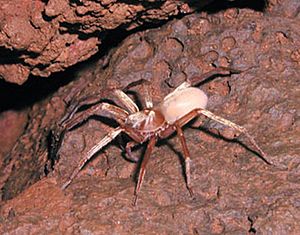Kauaʻi cave wolf spider facts for kids
Quick facts for kids Kauaʻi cave wolf spider |
|
|---|---|
 |
|
| Conservation status | |
| Scientific classification | |
 |
The Kauaʻi cave wolf spider (Adelocosa anops) is a very special spider. People who live nearby sometimes call it the "blind spider." This is because, unlike most spiders, it has no eyes at all!
This unique spider lives only in a few caves on the island of Kauaʻi in Hawaii. These caves are found in an old lava flow area. Scientists know of only six groups of these spiders in the world.
Contents
About the Kauaʻi Cave Wolf Spider
Appearance and Habitat
The Kauaʻi cave wolf spider is about 20 mm (0.8 in) long, which is about the size of a large paperclip. It has a reddish-brown color. Even though it's a wolf spider, it is completely harmless to people. It lives deep inside dark caves formed by ancient lava flows.
Diet and Prey
This spider is a hunter, but it doesn't use its eyes to find food since it's blind. Instead, it likely uses vibrations and other senses. Its main food is another rare cave creature called the Kauaʻi cave amphipod (Spelaeorchestia koloana).
The amphipod is a small, shrimp-like creature about 10 mm (0.4 in) long. It eats decaying plant material that washes into the caves. Both the spider and the amphipod are very important parts of the cave ecosystem.
Reproduction and Life Cycle
Most wolf spiders lay many eggs, but the Kauaʻi cave wolf spider is different. A female spider lays only about 15 to 30 eggs at a time. She keeps her eggs safe by carrying the egg sac in her mouthparts. She holds onto them carefully until the baby spiders hatch. This special way of caring for her young helps them survive in the cave environment.
Discovery and Conservation
The Kauaʻi cave wolf spider was first discovered by scientists in 1973. Since then, researchers have kept an eye on its population. They have never found more than 30 spiders or 80 amphipods at one time. This low number means both species are very rare and need protection. They are considered endangered, which means they are at high risk of disappearing forever. Protecting their cave homes is very important to help these unique creatures survive.
See also
In Spanish: Adelocosa anops para niños


